Article and Features
Giuseppe De Mattia’s fruit and vegetable stall at Matèria Gallery, Rome
“Sometimes the pleasure I feel entering a fruit and vegetable shop, set up with particular skill (mastery), surpasses that of seeing some art exhibitions!”
On the occasion of his second solo show at Matèria Gallery in Rome, Giuseppe De Mattia continues his ironic investigation into ways of producing, selling and consuming works of art. In the exhibition, the tricks and devices of the sale are subjected to an analytical look, becoming tools to trace and develop a self-reflective narrative that expose the acts of bargaining that take place in all commercial contexts, except in this environment with gallery owners, critics and potential collectors.
The fruit and vegetable shop has been a place of great fascination for De Mattia since his early childhood—in this context a repertoire of forms and practices that the artist selects and translates into a large scale environmental installation. Such fascination is above all aesthetic: the fruit shop reveals itself to be a place characterised by a precise vocabulary of scents, forms, colours and compositions; where the artisan showcases a product—through often elementary and ingenious display method, and which becomes intrinsic to the overall economic success. When this lexicon of display is transferred to the gallery, De Mattia stages a juxtaposition of objects transferred from the real market and his own produced ceramic works, inviting the viewer to share his fascinated gaze for a world often relegated to a more peripheral view. The overlap between the fruit store and the art gallery, two places where commercial success is closely related to the exhibiting a commodity-object, allows De Mattia to articulate his awareness of the structural conditionsthat frame his profession as an artist. According to the gallery press release, “It is neither an institutional critique, nor an attempt to expose the paradoxical mechanisms of the production of value, but rather the desire to declare what the rules of the game are, setting in (economic) reality the privileged gaze that the artist has on it.”
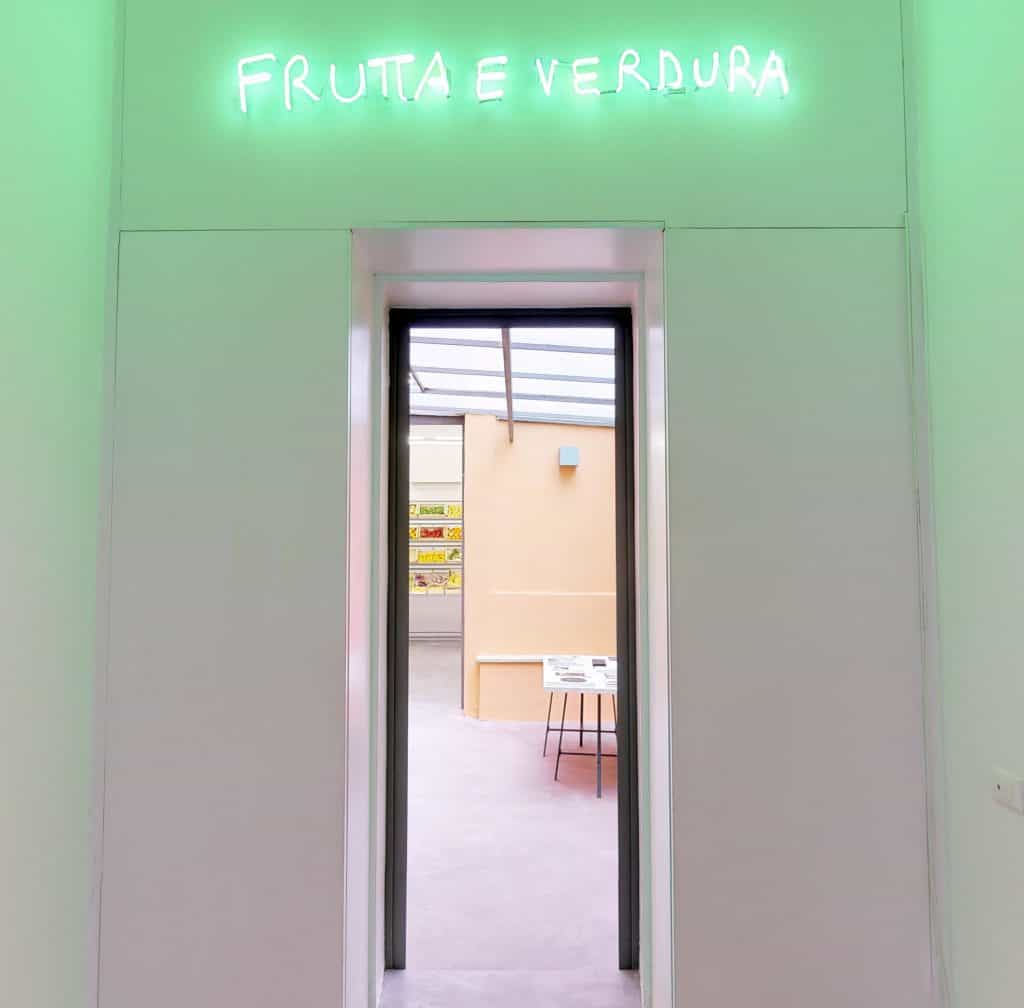
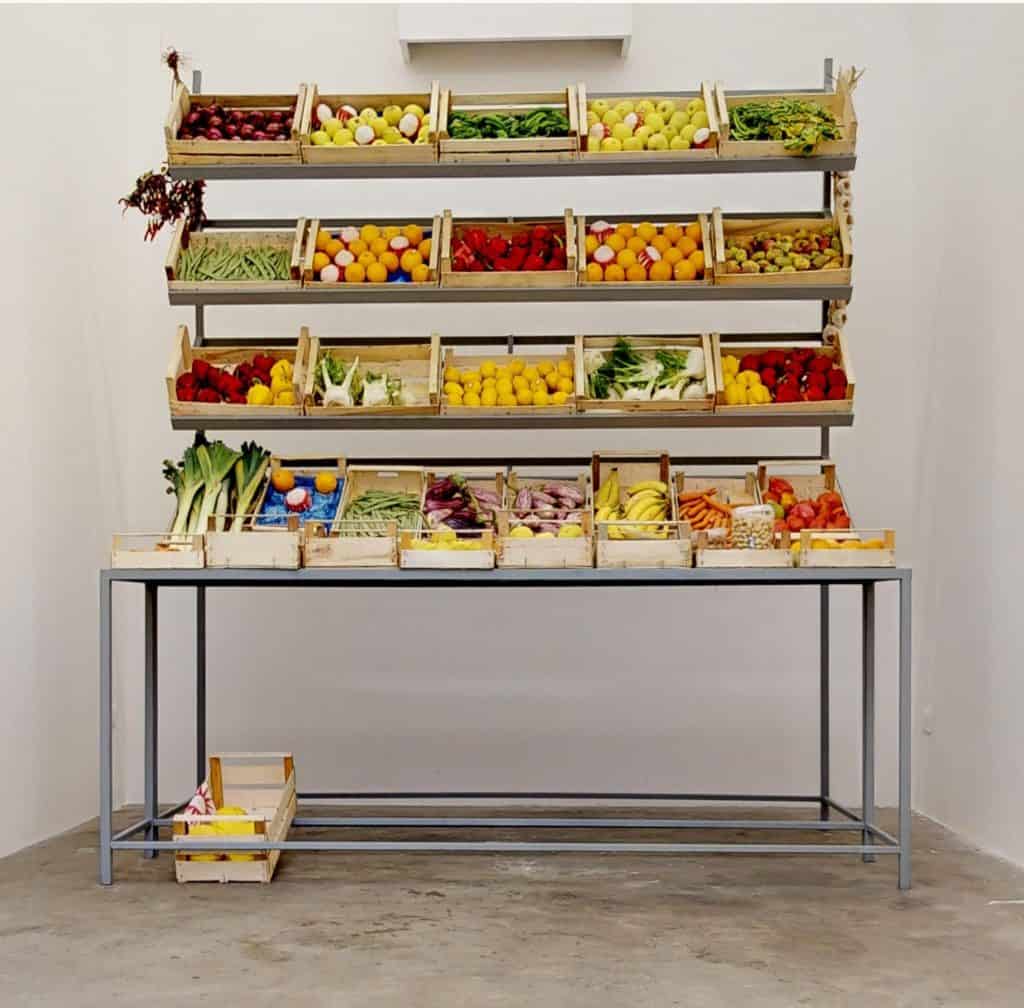
When entering the gallery, the viewer is met with an empty environment dominated by a pervasive green light and accompanied by the presence of a delicate plant based scent. Reproducing the artist’s irregular handwriting, the green neon sign, reading ‘frutta e verdura’ (fruit and vegetable) alludes to the temporary transformation of Matèria into a grocery retail space. At the same time, the autographic quality of the neon declares the artist’s authorship from the outset. In the second room, a display rack contains a composition of numerous crates containing seasonal fruits and vegetables, arranged by the artist to follow a precise chromatic scheme. Upon closer scrutiny the crates are revealed to also contain numerous hand-coloured ceramic sculptures of fruits and vegetables—kitsch ornamental ceramics repurposed as visual surrogates for the real counterparts they exist alongside.
The exhibition is curated by Vasco Forconi. Below is a transcript of an interview and conversation with and between Artland, the artist and curator:
Can you explain the different layers of experience a visitor gets while moving through the exhibition: first being immersed in the space full of green neon light and infused with particular scents and, secondly, standing in front of a typical fruit store, a sight one does not expect to encounter in a contemporary art gallery…
Vasco Forconi: For Esposizione di Frutta e Verdura we decided to work on creating two environmental installations, the idea of immersing the visitor in such a peculiar space was crucial in the conversations between Giuseppe and me. The first room of the gallery is deeply dematerialized: the green neon sign, combined with the natural scents, works as a form of anticipation to what is encountered in the main gallery space. The idea to trick the visitors’ senses through a synaesthetic approach seemed very interesting to us. Differently from what is suggested, when entering the second room one is faced with a strongly material installation. The fruit stand is quite oversized, which makes its functionality paradoxical. The white cube is a tricky device, but in the context of this project it worked quite effectively in helping us to pick, isolate, and exhibit fragments of reality that would otherwise be overlooked.
How did Materia Gallery respond to your idea of bringing a fruit stand into the white cube?
Giuseppe De Mattia: After my last solo show at Matèria in 2017, the gallery founder Niccolò Fano and I vowed to work differently. Niccolò deeply loves “his space”. He chose it four years ago after having visited several. He loves to see it “put to the test”—respected and violated at the same time. When we decided to make a new show, he asked me for a site-specific project. We often talk about the relationship between the art market and the basic goods, so I decided to take Niccolò to a grocery store a few meters from the gallery and told him that somehow I wanted to propose it in Matèria. It took no more than half an hour to get him to say yes. So then we invited Vasco Forconi to curate the project.
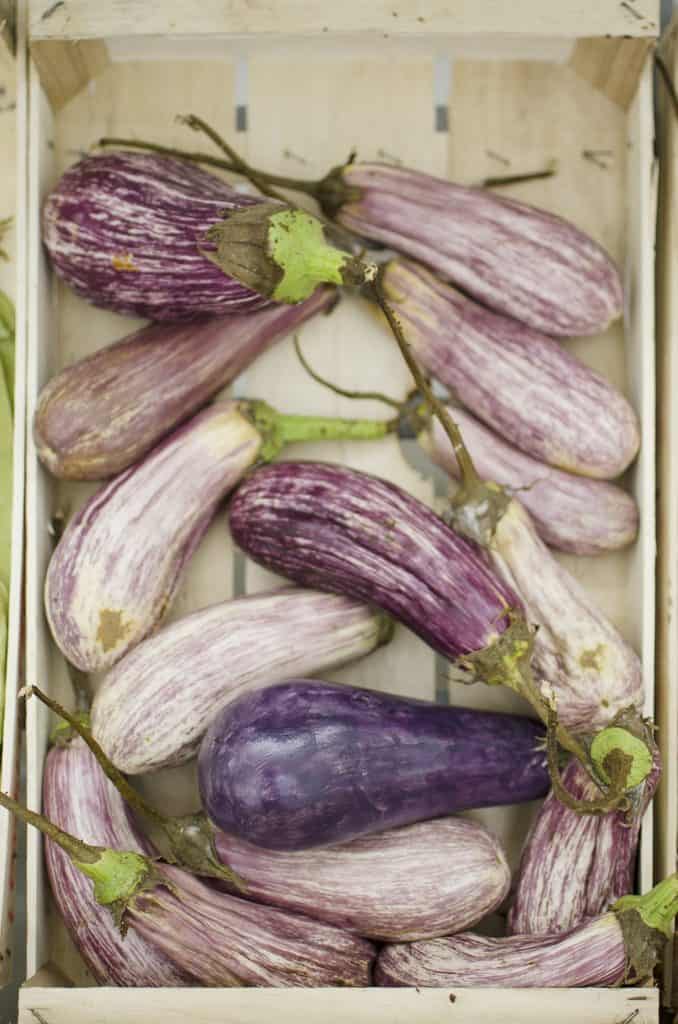
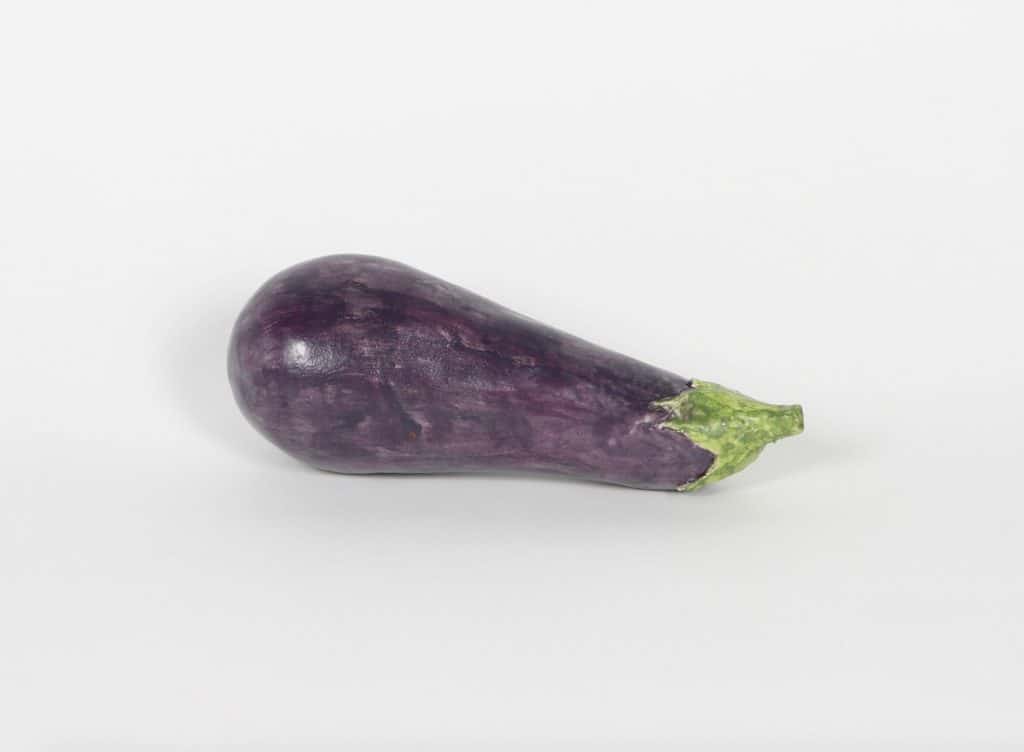
Considering that part of your show is perishable material, I imagine you have foreseen how the exhibition is going to unfold over time. From a delicious, colourful and inviting view to a slow descent into decay… How do you think this is going to be perceived by the audience?
Giuseppe De Mattia: The exhibition is designed to stage a time lapse. It changes over time, step by step. The title itself, Esposizione di Frutta e Verdura, plays on the ambiguity of the term “expose”. The installation was conceived as a “beauty contest” between organic elements and their ceramic copies. In the first phase, the one just before the opening, everything was perfect. The following day the aging and transformation of the work began. Many fruits have been sold at the inauguration, others have quickly rotted giving life to small insects. Since the second day the installation had changed profoundly and more and more in the following days. Now, just over a month after the inauguration, the exhibition has reached a new phase of stasis becoming a sort of still life. The metaphorical image that is generated is a work that becomes mature, sometimes rotten, sometimes more minimal, less and less organic, always different from the chromatic point of view. The viewer can follow its evolution by getting back to it after a long time. With this work I forced the gallery to take care of the artwork and become part of it, both in its state of maximum splendor and in its phase of decline.
You have used a pretty typical set-up as a prism through which to look at the art industry: the fruit stand with a variety of products very life-like, the aromatic herbs you can find in every Italian market, the apron with an old style embroidery.
Vasco Forconi: I think that the neon work is quite exemplary of Giuseppe De Mattia’s approach in this exhibition. At first it looks in line with a commercial sign, an intense green light indicating to passers-by the presence of a fruit and vegetable shop. But when you take a closer look you recognize the artist’s irregular handwriting. It’s almost as if De Mattia applies his signature on the entire exhibition. So there is always a tension between the will to collect materials from reality and to reclaim an artistic authorship of them. From this perspective the exhibition is also a homage to the talent of craftsmanship and the artisanal practice of showcasing a product. To go back to your question, the exhibition looks at the art industry fundamentally through the perspective of the artist. It is neither an institutional critique, nor an attempt to expose the paradoxical mechanisms of the production of value, but rather the desire to declare what the rules of the game are, setting in (economic) reality the privileged gaze that the artist has on it.
Giuseppe De Mattia: For the realization of a work, I am increasingly seeking collaboration with experienced craftsmen. In this case the collaboration with a family of Egyptian greengrocers was fundamental. One of this family’s stores is few meters away from the gallery. I started attending the store trying to learn how fruits and vegetables were arranged to attract customers. In my case they would have attracted a mixed audience, tempted to touch the artwork but at the same time prevented from doing so by virtue of where they are—the gallery environment. The style in the arrangement of fruit and vegetables, in reality, comes from far away. I used to go to fruit and vegetable markets when I was small, with my maternal grandfather. He himself had sold fruit and vegetables in the markets when he was young. Sometimes the pleasure I feel entering a fruit and vegetable shop, set up with particular skill (mastery), surpasses that of seeing some art exhibitions!
Was it your intention from the beginning to create such an ‘ironic investigation into the ways of producing, selling and consuming works of art’ or the project took this shape in the process? How do you both feel about today’s system of the art world? Does this exhibition transmit your idea and view on the current situation?
Vasco Forconi: Irony and bemusement have been central figures in Giuseppe De Mattia’s research for quite a long time. Esposizione di Frutta e Verdura further develops the artist’s amused fascination for selling and bargaining as both cultural and performative gestures. As for our existence within the artworld, I’d say the constant analysis of this condition fuels most of our discussions as both colleagues and friends – and friendship within such a system is something that holds a highly political potential. We acknowledge the paradox of paying homage to a rural and working-class imagery – both connected to our own family histories – while exhibiting in a private gallery, a place established for the selling of ‘luxury’ items. The objects of our research and their final consumers sit at two opposite extremes of the social spectrum, yet there is somewhat of a healing power and social redemption implicit in the possibility of working freely on such a project.
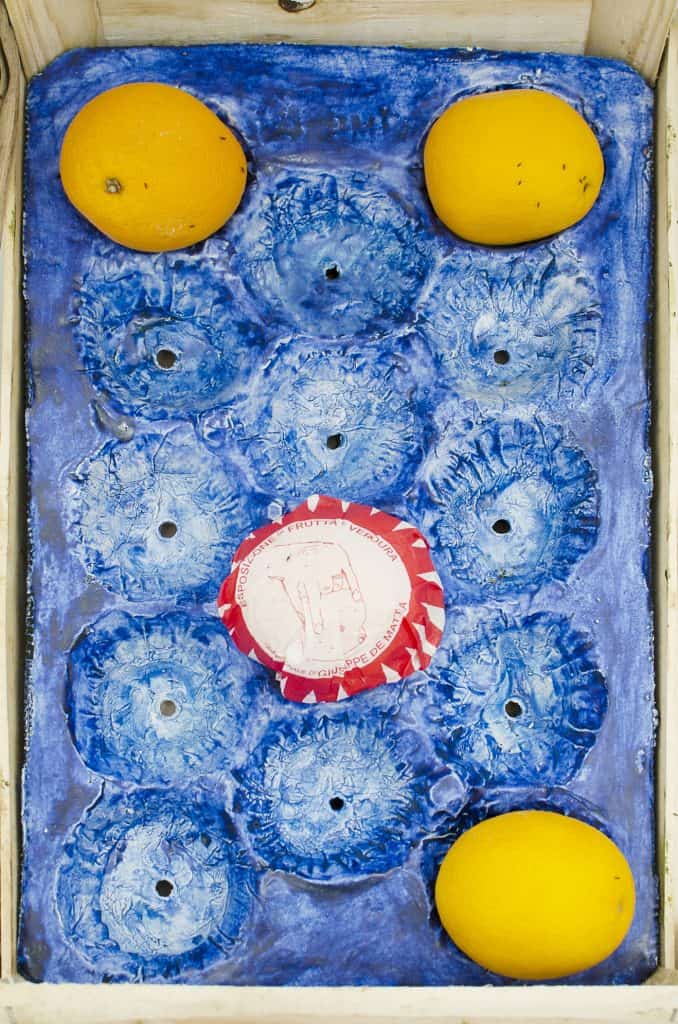
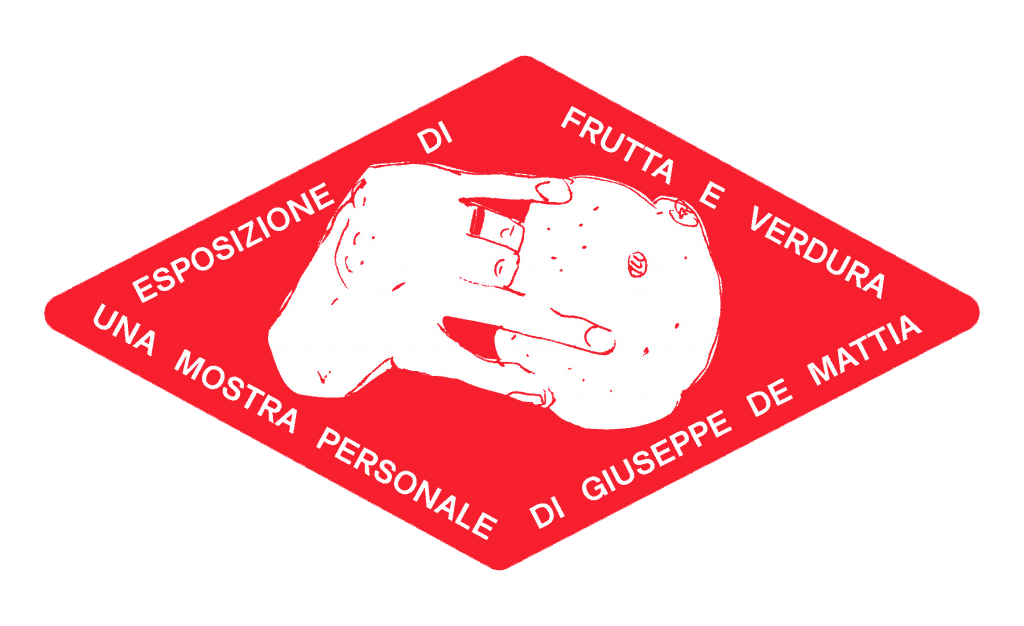
Giuseppe De Mattia: The exhibition lends itself to an operation of fragmentation and democratization of the sale of the work. There are tissue papers like those used to wrap oranges, personalized and printed in a limited edition of 500 items. Each of them is sold for € 5 and used to wrap one of the fruits in the gallery. The tissue was designed to become a fetish in the future, or one of the many crumpled pieces of paper that are put under glass like a relic, like an object that has existed, has had a common role in everyday life and now has acquired a more valuable identity. I can certainly say that we’ve sold so many artworks during the inauguration day! This operation of massive distribution of multiples belongs very much to my way of working that owes so much to the tradition of the artist’s multiples, at reasonable and populist prices, that I experienced growing up in the house of my parents.
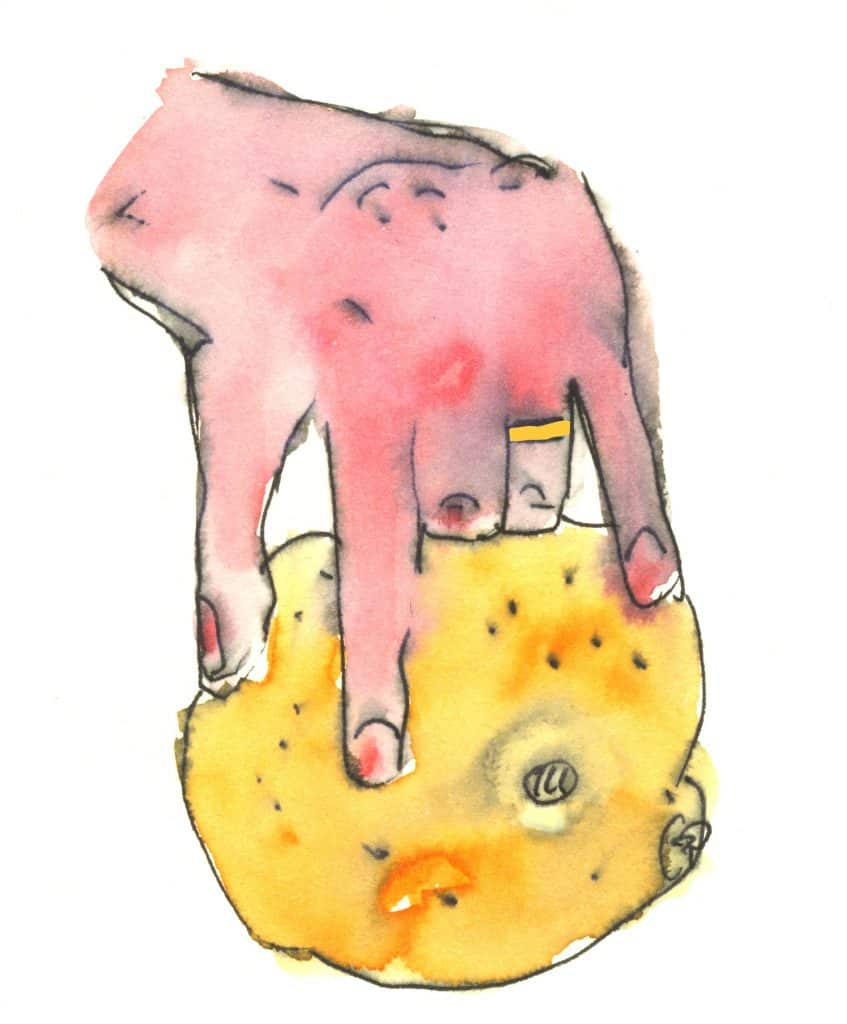
The superstitious gesture that you’ve used in the exhibition is very characteristic of some part of Italy. Can you explain it to the foreign audience?
Giuseppe De Mattia: My grandparents were superstitious, I am too. Where I come from, Apulia, superstition is a serious matter and ‘scaramanzia’ is even more so. My superstion does not reach patholigical peaks, I just like the hints of style in it. I remember some old men from my country, in the province of Bari, who had a gold or silver ‘cornetto’ (horn-shaped pendant) on the pocket watch chain. So, I like that form of superstition, the one mostly linked to the gesture, to the object-amulet, rather than to a true belief. It is neither religious nor magical, but before an exhibition, to wish that everything will go well, I make the gesture of the horns facing the floor. This time the gesture is widespread throughout the exhibition. It is also connected to my “family” of artists, my first audience, that group of people without whom I could do nothing.
Relevant sources to learn more
Visit Matèria Gallery Website
Read about Guglielmo Castelli studio visit